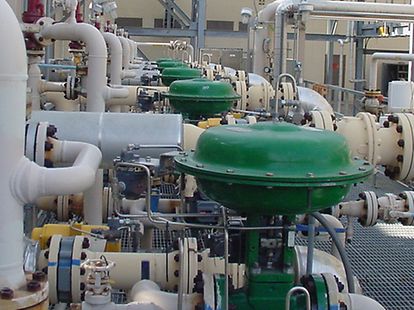
Maximize Power Savings and Convenience With Advanced Structure Automation Controls
In the world of contemporary style and center management, the combination of innovative structure automation controls stands as a crucial advancement. By utilizing the power of automation, structures can adapt, respond, and evolve in methods that were as soon as inconceivable.
Power Efficiency Conveniences
Power performance advantages can significantly decrease energy usage and functional prices in structures. By carrying out energy-efficient methods and innovations, structure owners and drivers can attain considerable cost savings while additionally adding to environmental sustainability. Among the key advantages of boosting power effectiveness in buildings is the reduction of utility costs. Energy-efficient systems, such as sophisticated building automation controls, can optimize the use of resources like illumination, cooling, and home heating, bring about reduced power expenses with time.
Furthermore, improved power performance can lengthen the lifespan of structure equipment and systems. By running much more efficiently, cooling and heating systems, lighting fixtures, and other structure elements experience less deterioration, resulting in lowered upkeep and substitute prices. Additionally, energy-efficient structures often regulate greater residential or commercial property values and rental prices, giving long-lasting economic benefits to proprietors.
Furthermore, power effectiveness can enhance passenger comfort and efficiency. Properly regulated interior environments with ideal lights and thermal conditions develop a more positive and helpful office, bring about enhanced staff member fulfillment and efficiency. Overall, the power efficiency benefits related to advanced structure automation controls are complex, encompassing expense financial savings, ecological stewardship, and occupant well-being.
Enhanced Comfort Control
Enhancing comfort control in building atmospheres calls for a sophisticated assimilation of advanced automation systems for optimal owner well-being. By utilizing sophisticated building automation controls, centers can customize the interior setting to meet the particular needs and preferences of residents. These systems allow exact guideline of ventilation, temperature level, and lights, producing a efficient and comfortable atmosphere. Resident contentment and performance are carefully linked to thermal convenience, making it vital to have systems in position that can adapt to transforming problems in real-time.
Improved comfort control goes past fundamental temperature modifications. It consists of features such as customized setups, occupancy sensors, and all-natural light usage to create a vibrant and responsive setting. By integrating these advanced controls, buildings can not just improve convenience but additionally boost energy performance by enhancing system operations based on actual tenancy and usage patterns. Inevitably, prioritizing owner comfort through sophisticated automation systems results in an extra delightful and healthier interior atmosphere.
Operational Efficiency Improvements

Moreover, the application of real-time surveillance and analytics tools makes it possible for building operators to recognize energy ineffectiveness and operational anomalies promptly. By continuously monitoring energy use next page patterns and system efficiency metrics, changes can be made in real-time to optimize energy usage and make sure peak operational effectiveness. control valves. Furthermore, including demand reaction strategies right into structure automation controls can further improve functional effectiveness by dynamically adjusting energy usage based upon grid problems and rates signals
Indoor Environment Optimization
Effective interior environment optimization is a basic facet of building automation controls, guaranteeing owners' comfort and wellness while making best use of power savings. By utilizing innovative sensors and controls, building automation systems can continuously readjust and monitor temperature, humidity degrees, air quality, and air flow to develop an optimum interior setting. Maintaining consistent and comfy conditions not just boosts occupant contentment yet likewise improves efficiency and general wellness.
Indoor climate optimization also plays an essential role in power performance. By fine-tuning cooling, ventilation, and home heating systems based upon real-time information and occupancy patterns, Click This Link developing automation controls can considerably reduce power usage - control valves. As an example, executing techniques such as demand-controlled ventilation and thermal zoning can assist reduce power waste while ensuring that each location of the structure receives the essential conditioning.

Sustainable Environment Development
Building automation controls not just maximize indoor environment conditions for power efficiency and passenger convenience however likewise lay the foundation for developing a lasting atmosphere with tactical management of systems and sources. By integrating innovative structure automation modern technologies, such as sensing units, actuators, and intelligent software, centers can adjust and monitor power usage in real-time to decrease waste and lower their carbon footprint. These systems enable anticipating maintenance, identifying possible issues before they intensify and maximizing tools efficiency to improve longevity and effectiveness.
In addition, lasting setting development prolongs beyond power management to incorporate water conservation, waste decrease, and indoor air top quality improvement. Building automation controls can manage water usage, detect leakages, and ensure appropriate garbage disposal practices, contributing to total sustainability initiatives. In addition, by keeping an eye on and managing ventilation and filtering systems, these technologies boost passenger health and wellness and productivity while decreasing energy consumption related to HVAC procedures.
Final Thought
To conclude, progressed building automation manages deal significant benefits in regards to power financial savings, convenience control, functional efficiency, interior climate optimization, and creating a lasting setting. By carrying out these controls, structures can accomplish optimal efficiency while reducing energy intake and boosting occupant comfort. It is apparent that the usage of advanced automation innovation is critical in boosting structure performance and producing a much more lasting future.
Energy effectiveness benefits can dramatically reduce energy consumption and operational expenses in buildings. Overall, the power effectiveness advantages connected with innovative building automation controls are complex, incorporating expense savings, ecological stewardship, and resident health.
In addition, integrating demand action approaches right into structure automation controls can even more improve operational performance by dynamically changing energy use based on grid conditions and rates signals.
Building automation controls not just maximize indoor environment problems for energy performance and passenger convenience but additionally lay the foundation for producing a lasting setting via critical management of sources and systems.In conclusion, advanced building automation controls offer considerable benefits in terms of energy financial savings, convenience control, operational effectiveness, indoor environment optimization, and creating a lasting environment.